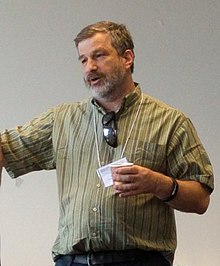Moni Naor
Moni Naor (* 1961 ) is an Israeli computer scientist. He is a professor at the Weizmann Institute . Together with Adi Shamir, he is considered to be one of the founders of visual cryptography (1994).
Naor received her PhD in 1989 from the University of California, Berkeley with Manuel Blum ( Implicit storage schemes for quick retrieval ).
He is also known for his work on malleable (translated: deformable) cryptosystems (with Danny Dolev, Cynthia Dwork ), an undesirable property (for example in electronic bank transfers) in which an attacker can generate plain text with similar content by changing the ciphertext . He introduced Proof of Work with Cynthia Dwork .
Like his teacher Manuel Blum, he also contributed to the captcha idea.
In 2008 he became a Fellow of the International Association for Cryptologic Research (IACR). In 2014, he and Ronald Fagin and Amnon Lotem received the Gödel Prize from ACM and EATCS for their work Optimal Aggregation Algorithms for Middleware , which introduced the threshold algorithm and instance optimality . For 2016 Naor - together with Fiat Amos - was awarded the Paris Kanellakis Prize .
Omer Reingold is one of his PhD students .
Fonts
- Editor Theory of Cryptography , First Theory of Cryptography Conference, TCC 2004, Cambridge, MA, USA, 19. – 21. February 2004, Springer Verlag 2004
Web links
Individual evidence
- ↑ Naor, Shamir Visual Cryptography , Eurocrypt 1994, pp. 1-12
- ↑ Moni Naor in the Mathematics Genealogy Project (English)
- ↑ Danny Dolev, Cynthia Dwork, Moni Naor Nonmalleable Cryptography , SIAM Journal on Computing, Volume 30, 2000, 391–437
- ↑ J. Comput. Syst. Sci., Vol. 66, 2003, pp. 614-656
| personal data | |
|---|---|
| SURNAME | Naor, Moni |
| BRIEF DESCRIPTION | Israeli computer scientist |
| DATE OF BIRTH | 1961 |
